soviet union
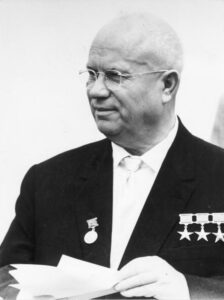 It’s never a good idea to find your nation behind it’s enemies in the arms race. Never was that made more clear than during the Cold War. It’s also not a good idea to begin to brag to your enemies about the superiority of your nation over theirs concerning the nation’s arms race status. Nevertheless, in a long and rambling interview with an American reporter on November 15, 1957, Soviet leader Nikita Khrushchev claimed that the Soviet Union had missile superiority over the United States. He then went on to challenge America to a missile “shooting match” to prove his assertion. It was a bold move, and one that fueled fears in the United States that the nation was indeed falling behind the Soviets in the arms race. People began to worry about not only the idea of the United States falling behind in the arms race, but also the idea that the Soviet Union and Nikita Khrushchev might actually launch their missiles at the US.
It’s never a good idea to find your nation behind it’s enemies in the arms race. Never was that made more clear than during the Cold War. It’s also not a good idea to begin to brag to your enemies about the superiority of your nation over theirs concerning the nation’s arms race status. Nevertheless, in a long and rambling interview with an American reporter on November 15, 1957, Soviet leader Nikita Khrushchev claimed that the Soviet Union had missile superiority over the United States. He then went on to challenge America to a missile “shooting match” to prove his assertion. It was a bold move, and one that fueled fears in the United States that the nation was indeed falling behind the Soviets in the arms race. People began to worry about not only the idea of the United States falling behind in the arms race, but also the idea that the Soviet Union and Nikita Khrushchev might actually launch their missiles at the US.
Khrushchev tried to compare the arms race to the space race, saying that if the United States had intercontinental ballistic rockets, “she had would have launched her own Sputnik.” Khrushchev was crossing boastful belligerence and calls for “peaceful coexistence” with the West, in what was a classic move for him. He bragged about Soviet missile superiority, claiming that the United States did not have what the Soviet Union had. Then, as cool as a cucumber, he issued a challenge, saying, “Let’s have a peaceful rocket contest just like a rifle-shooting match, and they’ll see for themselves.”
Following his fear-inspiring statements, Khrushchev began to speak about the future of East-West relations, saying that the American and Soviet people both wanted peace. He cautioned that although the Soviet Union would never start a war, “some lunatics” might bring about a conflict. In particular, he noted that Secretary of State John Foster Dulles had created “an artificial war psychosis.” In the case of war, it “would be fought on the American continent, which can be reached by our rockets.” NATO forces in Europe would also be devastated, and Europe “might become a veritable cemetery.” While the Soviet Union would “suffer immensely,” the forces of communism would ultimately destroy capitalism.
Khrushchev made these remarks just a few days after the Gaither Report had been leaked to the press in the 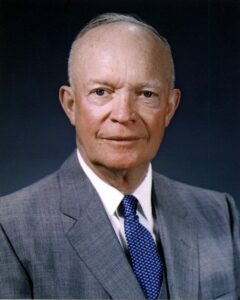 United States. The report supported many of the Russian leader’s contentions, charging that the United States was falling far behind the Soviets in the arms race. Of course, the critics of President Dwight D Eisenhower’s foreign policy, especially the Democratic Party, went on the attack, calling Eisenhower weak. The Gaither Report called for “an urgent strengthening of US missile technology, along with offensive and defensive military capabilities. The report also called for a fifty percent increase in US military spending and a redesign of the US Defense Department.” The Gaither Report was presented to President Eisenhower on November 7, 1957. The report suggested that Eisenhower’s military policy…the reliance on cheap nuclear weapons instead of expensive Army divisions…was inadequate. He kept the Report secret and generally ignored it, but its conclusions were leaked to the press. The public debate concerning the alleged “missile gap” between US and Soviet rocket arsenals continued through the early 1960s and became a major issue in the 1960 presidential campaign between Richard Nixon and John F Kennedy.
United States. The report supported many of the Russian leader’s contentions, charging that the United States was falling far behind the Soviets in the arms race. Of course, the critics of President Dwight D Eisenhower’s foreign policy, especially the Democratic Party, went on the attack, calling Eisenhower weak. The Gaither Report called for “an urgent strengthening of US missile technology, along with offensive and defensive military capabilities. The report also called for a fifty percent increase in US military spending and a redesign of the US Defense Department.” The Gaither Report was presented to President Eisenhower on November 7, 1957. The report suggested that Eisenhower’s military policy…the reliance on cheap nuclear weapons instead of expensive Army divisions…was inadequate. He kept the Report secret and generally ignored it, but its conclusions were leaked to the press. The public debate concerning the alleged “missile gap” between US and Soviet rocket arsenals continued through the early 1960s and became a major issue in the 1960 presidential campaign between Richard Nixon and John F Kennedy.
 Some nations really can’t be trusted with weapons of mass destruction. They are eager to start a war, and they don’t have the moral scruples necessary to care about the loss of life involved. When nuclear weapons began to be produced, nations like the Soviet Union, China, Germany, Iran, Iraq, and various others, simply couldn’t be trusted with these weapons, but it was difficult to stop them from developing them, just like it is today. Therefore, nations have had to develop ways to restrict the usage of these weapons.
Some nations really can’t be trusted with weapons of mass destruction. They are eager to start a war, and they don’t have the moral scruples necessary to care about the loss of life involved. When nuclear weapons began to be produced, nations like the Soviet Union, China, Germany, Iran, Iraq, and various others, simply couldn’t be trusted with these weapons, but it was difficult to stop them from developing them, just like it is today. Therefore, nations have had to develop ways to restrict the usage of these weapons.
On July 21, 1955, President Dwight D Eisenhower presented his “Open Skies” plan at the 1955 Geneva summit meeting with Prime Minister Anthony Eden of Great Britain, Premier Edgar Faure of France, and Premier Nikolai Bulganin of the Soviet Union…acting for Soviet leader Nikita Khrushchev, in Geneva in July 1955, to present the plan. The plan was never accepted, but it laid the foundation for President Ronald Reagan’s “Trust, But Verify” policy in relation to arms agreements with the Soviet Union. The planned agenda for the summit included discussions on the future of Germany and arms control, but as it became clear that no agreement could be 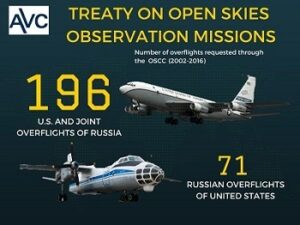 reached on the issue of possible German reunification or the precise configuration of an arms control agreement, considering what had happened in Germany after World War I, Eisenhower dramatically unveiled what came to be known as his “Open Skies” proposal. The proposal called for the United States and the Soviet Union to exchange maps indicating the exact location of every military installation in their respective nations. The purpose of the maps was to allow each nation to conduct aerial surveillance of the installations in order to assure that the other nations were in compliance with any arms control agreements that might be reached. While it sounded like a good idea, it had little chance of acceptance. The French and British expressed interest in the idea, but the Soviets rejected any plan that would leave their nation subject to surveillance by a Western power. Khrushchev declared that Eisenhower’s “Open Skies” was nothing more than an “espionage plot.”
reached on the issue of possible German reunification or the precise configuration of an arms control agreement, considering what had happened in Germany after World War I, Eisenhower dramatically unveiled what came to be known as his “Open Skies” proposal. The proposal called for the United States and the Soviet Union to exchange maps indicating the exact location of every military installation in their respective nations. The purpose of the maps was to allow each nation to conduct aerial surveillance of the installations in order to assure that the other nations were in compliance with any arms control agreements that might be reached. While it sounded like a good idea, it had little chance of acceptance. The French and British expressed interest in the idea, but the Soviets rejected any plan that would leave their nation subject to surveillance by a Western power. Khrushchev declared that Eisenhower’s “Open Skies” was nothing more than an “espionage plot.”
The truth is that “Open Skies” was definitely not an “espionage plot,” but then we all knew that. Eisenhower was later quoted as saying that he knew “the Soviets would never accept the plan, but thought that their rejection of the idea would make the Russians look like they were the major impediment to an arms control  agreement.” The problem the Soviets had was that US surveillance planes would quickly find out that the Soviet Union was far behind the United States in terms of its military capabilities. The United States soon found that out anyway, because just a few months after the Soviet rejection of “Open Skies,” the Eisenhower administration approved the use of high-altitude spy planes (the famous U-2s) for spying on the Soviet Union. Thirty years later, President Reagan would use much the same rhetoric in his arms control dealings with the Soviet Union. Arms control, he declared, could only be effective if compliance with such agreements could be verified. “Trust, but verify” became Reagan’s standard phrase, and the truth is they were both right. If these rogue nations can’t be held accountable, they will continue to develop weapons of mass destruction, even while they are in a supposed agreement not to.
agreement.” The problem the Soviets had was that US surveillance planes would quickly find out that the Soviet Union was far behind the United States in terms of its military capabilities. The United States soon found that out anyway, because just a few months after the Soviet rejection of “Open Skies,” the Eisenhower administration approved the use of high-altitude spy planes (the famous U-2s) for spying on the Soviet Union. Thirty years later, President Reagan would use much the same rhetoric in his arms control dealings with the Soviet Union. Arms control, he declared, could only be effective if compliance with such agreements could be verified. “Trust, but verify” became Reagan’s standard phrase, and the truth is they were both right. If these rogue nations can’t be held accountable, they will continue to develop weapons of mass destruction, even while they are in a supposed agreement not to.
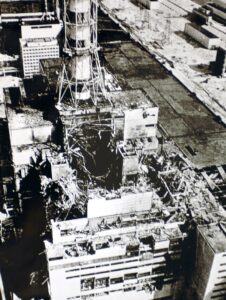 It seems an impossible task, to keep a disaster a secret, and yet that is exactly what the Soviet Union tried to do when disaster struck on April 26, 1986, at the No. 4 reactor in the Chernobyl Nuclear Power Plant, near the city of Pripyat in the north of the Ukrainian SSR. Chernobyl is considered the worst nuclear disaster in history. In terms of cost and casualties, and it is one of only two nuclear energy accidents rated at seven, which is the maximum severity, on the International Nuclear Event Scale. The other disaster was the well known 2011 Fukushima Daiichi nuclear disaster in Japan that was caused by a tsunami.
It seems an impossible task, to keep a disaster a secret, and yet that is exactly what the Soviet Union tried to do when disaster struck on April 26, 1986, at the No. 4 reactor in the Chernobyl Nuclear Power Plant, near the city of Pripyat in the north of the Ukrainian SSR. Chernobyl is considered the worst nuclear disaster in history. In terms of cost and casualties, and it is one of only two nuclear energy accidents rated at seven, which is the maximum severity, on the International Nuclear Event Scale. The other disaster was the well known 2011 Fukushima Daiichi nuclear disaster in Japan that was caused by a tsunami.
On April 28, 1986, two days after monitoring stations in Sweden, Finland and Norway began reporting sudden high discharges of radioactivity in the atmosphere, the Soviet Union finally broke the news by way of their official news agency, Tass. Two days!! In the realm of nuclear contamination, two days is an eternity!! When the Soviet Union finally told the world, Tass simply said there had been an accident at the Chernobyl nuclear power plant in Ukraine. They didn’t say they had tried to hide it, but two days of no response tells me they did. The initial emergency response, together with later decontamination of the environment, ultimately involved more than 500,000 personnel and cost an estimated 18 billion Soviet rubles, which is roughly $68 billion US dollars as of the dollar value in 2019.
It was determined that the accident had started during a safety test on an RBMK-type nuclear reactor. During testing a simulation of an electrical power outage was used to help create a safety procedure for maintaining reactor cooling water circulation until the back-up electrical generators could provide power. These units had been tested three times since 1982, but they had failed to provide a solution. On this fourth attempt, an unexpected 10-hour delay meant that an unprepared operating shift was on duty. The power unexpectedly dropped to a near-zero level during the planned decrease of reactor power in preparation for the electrical test. The operators were only able to partially restore the specified test power, putting the reactor in an unstable condition. This risk was not made evident in the operating instructions, so the operators proceeded with the electrical test. Upon test completion, the operators triggered a reactor shutdown, but a combination of unstable conditions and reactor design flaws caused an uncontrolled nuclear chain reaction instead.
The failure caused a large amount of energy to be suddenly released, followed by two explosions that ruptured 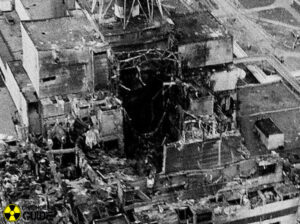 the reactor core and destroyed the reactor building. One was a highly destructive steam explosion from the vaporizing superheated cooling water. The other explosion could have been another steam explosion or a small nuclear explosion, like a nuclear fizzle. The explosions were followed immediately by an open-air reactor core fire that released considerable airborne radioactive contamination for about nine days. The contamination fell onto parts of the USSR and western Europe, especially 10 miles away in Belarus, where around 70% landed, before finally being contained on May 4, 1986. In addition to the contamination released by the explosions, the fire gradually released about the same amount of contamination as did the initial explosion. As a result of rising radiation levels in surrounding regions, a 6.2 mile radius exclusion zone was created 36 hours after the accident. About 49,000 people were evacuated from the area, primarily the citizens of Pripyat. Later the exclusion zone was increased to 19 mile radius, and an additional 68,000 people were evacuated from the wider area.
the reactor core and destroyed the reactor building. One was a highly destructive steam explosion from the vaporizing superheated cooling water. The other explosion could have been another steam explosion or a small nuclear explosion, like a nuclear fizzle. The explosions were followed immediately by an open-air reactor core fire that released considerable airborne radioactive contamination for about nine days. The contamination fell onto parts of the USSR and western Europe, especially 10 miles away in Belarus, where around 70% landed, before finally being contained on May 4, 1986. In addition to the contamination released by the explosions, the fire gradually released about the same amount of contamination as did the initial explosion. As a result of rising radiation levels in surrounding regions, a 6.2 mile radius exclusion zone was created 36 hours after the accident. About 49,000 people were evacuated from the area, primarily the citizens of Pripyat. Later the exclusion zone was increased to 19 mile radius, and an additional 68,000 people were evacuated from the wider area.
When the reactor exploded, two of the reactor operating staff lost their lives instantly. Crews rushed to put out the fire, stabilize the reactor, and cleanup the ejected nuclear core. As a result of the disaster and immediate response, 134 station staff and firemen were hospitalized with acute radiation syndrome due to absorbing high doses of ionizing radiation. In the days to months afterward 28 of these 134 people died, and approximately 14 suspected radiation-induced cancer deaths followed within the next 10 years. Significant cleanup operations were taken in the exclusion zone to deal with local fallout, and the exclusion zone was made permanent. The cities in the zone remain abandoned.
By 2011, an excess of 15 childhood thyroid cancer deaths were documented among the wider population. The United Nations Scientific Committee on the Effects of Atomic Radiation (UNSCEAR) has reviewed all the published research on the incident multiple times, and found that at present, fewer than 100 documented deaths are likely to be attributable to increased exposure to radiation. Of course, there is no way to be sure of that information, because “determining the total eventual number of exposure related deaths is uncertain based on the linear no-threshold model, a contested statistical model, which has also been used in estimates of low level radon and air pollution exposure.” When the expected deaths is viewed in “model predictions with the greatest confidence values of the eventual total death toll in the decades ahead from Chernobyl releases vary, from 4,000 fatalities when solely assessing the three most contaminated former Soviet states, to about 9,000 to 16,000 fatalities when assessing the total continent of Europe. In an effort to reduce the spread of radioactive contamination from the wreckage and protect it from weathering, the protective Chernobyl Nuclear  Power Plant sarcophagus was built by December 1986. It also provided radiological protection for the crews of the undamaged reactors at the site, which continued operating. Due to the continued deterioration of the sarcophagus, it was further enclosed in 2017 by the Chernobyl New Safe Confinement, a larger enclosure that allows the removal of both the sarcophagus and the reactor debris, while containing the radioactive hazard. Nuclear clean-up is scheduled for completion in 2065.” It is my opinion that if they had acted immediately to evacuate the people in surrounding areas, they might have reduced the number of deaths substantially. Keeping the accident a secret for two days was insane, and very likely criminal.
Power Plant sarcophagus was built by December 1986. It also provided radiological protection for the crews of the undamaged reactors at the site, which continued operating. Due to the continued deterioration of the sarcophagus, it was further enclosed in 2017 by the Chernobyl New Safe Confinement, a larger enclosure that allows the removal of both the sarcophagus and the reactor debris, while containing the radioactive hazard. Nuclear clean-up is scheduled for completion in 2065.” It is my opinion that if they had acted immediately to evacuate the people in surrounding areas, they might have reduced the number of deaths substantially. Keeping the accident a secret for two days was insane, and very likely criminal.
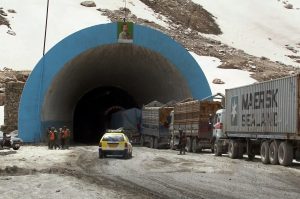 Sometimes when a vehicle accident occurs, one or both vehicles catch on fire. It is almost to be expected periodically, but it is almost never expected to be catastrophic. Nevertheless, on November 2, 1982, such an accident occurred in the Salang Tunnel in Afghanistan, and it cost 3,000 people their lives. Most of the victims were Soviet soldiers traveling to Kabul.
Sometimes when a vehicle accident occurs, one or both vehicles catch on fire. It is almost to be expected periodically, but it is almost never expected to be catastrophic. Nevertheless, on November 2, 1982, such an accident occurred in the Salang Tunnel in Afghanistan, and it cost 3,000 people their lives. Most of the victims were Soviet soldiers traveling to Kabul.
The entrance into Afghanistan by the Soviet Union that year was disastrous in nearly every way, but possibly the worst single incident was the Salang Tunnel explosion. At the time of the crash, a long army convoy was traveling from Russia to Kabul through the border city of Hairotum. The route took the convoy through the Salang Tunnel, which is 1.7 miles long, 25 feet high and approximately 17 feet wide. The tunnel is one of the world’s highest at an altitude of 11,000 feet. It was built by the Soviets in the 1970s.
As was common in those days, the Soviet army kept a tight lid on the story. It is believed that an army vehicle  collided with a fuel truck about half way through the long tunnel. When the fuel truck exploded, about 30 buses carrying soldiers were immediately blown up. Fire in the tunnel spread quickly and the survivors of the blast began to panic. The ensuing chaos made the military stationed at the ends of the tunnel believe the explosion was part of an attack. As per protocol for terrorist attacks, the military stationed at both ends of the tunnel stopped traffic from exiting. If the fire wasn’t enough, the idling cars in the tunnel caused the levels of carbon monoxide in the air to increase drastically, The fire continued to spread as well. Exacerbating the situation, the tunnel’s ventilation system had broken down a couple of days earlier, resulting in further casualties from burns and carbon monoxide poisoning.
collided with a fuel truck about half way through the long tunnel. When the fuel truck exploded, about 30 buses carrying soldiers were immediately blown up. Fire in the tunnel spread quickly and the survivors of the blast began to panic. The ensuing chaos made the military stationed at the ends of the tunnel believe the explosion was part of an attack. As per protocol for terrorist attacks, the military stationed at both ends of the tunnel stopped traffic from exiting. If the fire wasn’t enough, the idling cars in the tunnel caused the levels of carbon monoxide in the air to increase drastically, The fire continued to spread as well. Exacerbating the situation, the tunnel’s ventilation system had broken down a couple of days earlier, resulting in further casualties from burns and carbon monoxide poisoning.
Rescue and recovery was slow due to the lack of safe working conditions for rescue crews. It took several days for workers to reach all the bodies in the tunnel. To make matters worse, the Soviet army limited the 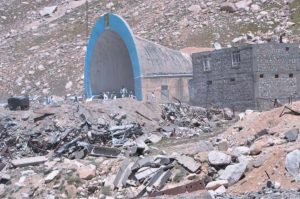 information released about the disaster, so we may never know the full extent of the tragedy. While the fire and carbon monoxide poisonings were tragic in and of themselves, the fact that the military thought the accident might be a terrorist attack, really caused the massive amounts of death. The people in the tunnel were trapped, and there was no ventilation. They couldn’t get away from the death enveloping them on all sides. I’m sure there was panic and screaming, making the chaos even worse. The very thought of all those people trapped in that tunnel makes me feel nauseous, and I’m sure that if the Soviets kept it under wraps, there were families who never knew what happened to their loved ones.
information released about the disaster, so we may never know the full extent of the tragedy. While the fire and carbon monoxide poisonings were tragic in and of themselves, the fact that the military thought the accident might be a terrorist attack, really caused the massive amounts of death. The people in the tunnel were trapped, and there was no ventilation. They couldn’t get away from the death enveloping them on all sides. I’m sure there was panic and screaming, making the chaos even worse. The very thought of all those people trapped in that tunnel makes me feel nauseous, and I’m sure that if the Soviets kept it under wraps, there were families who never knew what happened to their loved ones.
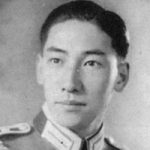 Yang Kyoungjong was a Korean man with an incredible story. In 1938, when he was 18 years old, Kyoungjong was in Manchuria when he was forced into the Kwantung Army of the Imperial Japanese Army to fight against the Soviet Union. It was the outbreak of World War II, and I suppose the Japanese decided they would be better off to make him soldier than to let him languish in a prisoner of war camp. So, fight he did. Korea was ruled by Japan at that time, and Kyoungjong really had no choice to to follow orders.
Yang Kyoungjong was a Korean man with an incredible story. In 1938, when he was 18 years old, Kyoungjong was in Manchuria when he was forced into the Kwantung Army of the Imperial Japanese Army to fight against the Soviet Union. It was the outbreak of World War II, and I suppose the Japanese decided they would be better off to make him soldier than to let him languish in a prisoner of war camp. So, fight he did. Korea was ruled by Japan at that time, and Kyoungjong really had no choice to to follow orders.
During the Battle of Khalkhin Gol, things weren’t going well for the Japanese army, and Kyoungjong was again captured…this time by the Soviet Red Army. He was sent to a Gulag labor camp. While he was there, and with Soviet manpower shortages being what they were, Kyoungjong was presses into service in the Soviet army in 1942. He, along with thousands of other prisoners, were told to fight with the Red Army against Nazi Germany. He was sent to the Eastern Front of Europe.
Somehow, Kyoungjong managed to always be in the wrong place at the wrong time. In 1943, he was once again captured, this time by the Wehrmacht soldiers in eastern Ukraine during the Third Battle of Kharkov. He  was pressed into service again, and told that he had joined the “Eastern Battalions” to fight for Germany. Kyoungjong was sent to Occupied France to serve in a battalion of former Soviet prisoners of war on the Cotentin peninsula in Normandy, close to Utah Beach. I’m sure he wondered which army he was really a part of.
was pressed into service again, and told that he had joined the “Eastern Battalions” to fight for Germany. Kyoungjong was sent to Occupied France to serve in a battalion of former Soviet prisoners of war on the Cotentin peninsula in Normandy, close to Utah Beach. I’m sure he wondered which army he was really a part of.
During the D-Day landings in northern France by the Allied forces, Kyoungjong was captured by paratroopers of the United States Army in June 1944. The American Army thought he was a Japanese soldier in German uniform at first. At the time, Lieutenant Robert Brewer of the 506th Parachute Infantry Regiment, 101st Airborne Division, reported that his regiment had “captured four Asians in German uniform after the Utah Beach landings, and that initially no one was able to communicate with them.” The good news for Kyoungjong was that he was not going to again be expected to fight with a different army. He was first sent to a prison camp in Britain and later transferred to a camp in the United States.
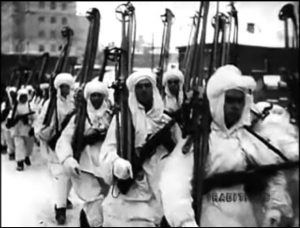 As a part of his planned world takeover, Hitler had sent his forces to invade the Soviet Union in June 1941. Early on it had become one relentless push inside Russian territory, but the Nazis experienced their first setback in August, when the Soviet Army’s tanks drove the Germans back from the Yelnya salient. A shocked Adolf Hitler told General Bock at the time, “Had I known they had as many tanks as that, I’d have thought twice before invading.” Personally, I doubt that it would have made any difference. Hitler did not particularly care about the lives of his men, just that they perform as they were ordered. For the men, there was no turning back because Hitler would not be moved. Hitler firmly believed that he was destined and well able to succeed in dominating the Soviet Union and capturing Moscow, where others had failed.
As a part of his planned world takeover, Hitler had sent his forces to invade the Soviet Union in June 1941. Early on it had become one relentless push inside Russian territory, but the Nazis experienced their first setback in August, when the Soviet Army’s tanks drove the Germans back from the Yelnya salient. A shocked Adolf Hitler told General Bock at the time, “Had I known they had as many tanks as that, I’d have thought twice before invading.” Personally, I doubt that it would have made any difference. Hitler did not particularly care about the lives of his men, just that they perform as they were ordered. For the men, there was no turning back because Hitler would not be moved. Hitler firmly believed that he was destined and well able to succeed in dominating the Soviet Union and capturing Moscow, where others had failed.
So, on October 2, 1941, the Germans began their surge toward Moscow, led by the 1st Army Group under the General Fedor von Bock. The Germans and Hitler thought they could come in and mow the people down with no resistance. Then they thought they could take their resources from the people to sustain them through the winter months, while they continued to plunder the country. The Russian peasants had different ideas, however.  As the Germans approached, the peasants in their path employed a “scorched earth” policy. I’m not a veteran or anything, so somehow I hadn’t heard of this strategy. The idea is to destroy anything and everything that could be useful to the enemy.
As the Germans approached, the peasants in their path employed a “scorched earth” policy. I’m not a veteran or anything, so somehow I hadn’t heard of this strategy. The idea is to destroy anything and everything that could be useful to the enemy.
This strategy could prove especially useful for the Soviet Union because of the harsh Russian winter. The Russians remembered Napoleon and the fateful winter he and his men spent in the frigid Russian winter. The peasants began destroying everything as they fled their villages, fields, and farms. Harvested crops were burned, livestock were driven away, and buildings were blown up, leaving nothing of value behind to support exhausted troops. Hitler’s army invaded Russia to find nothing but ruins. On top of the lack of shelter and food, winter was upon them, and they were in trouble.
Hitler was a stubborn cuss, and although some German generals had warned him against launching Operation Typhoon as the harsh Russian winter was just beginning, he would not be moved. The generals remembered the fate of Napoleon, who got stuck in horrendous conditions. Over the course of that winter, Napoleon lost  serious numbers of men and horses. Still, some people urged him on. This encouragement, coupled with the fact that the German army had taken the city of Kiev in late September, caused Hitler to declare, “The enemy is broken and will never be in a position to rise again.” So for 10 days, starting October 2, the 1st Army Group drove east, drawing closer to the Soviet capital each day, but by the time the operation was over on January 7, 1942, the German army had not reached Moscow. German casualties amounted to 460,000 men, many of whom were frozen to death due to the lack of proper clothing to handle the harsh Russian winters. It was a catastrophic loss to the the German army.
serious numbers of men and horses. Still, some people urged him on. This encouragement, coupled with the fact that the German army had taken the city of Kiev in late September, caused Hitler to declare, “The enemy is broken and will never be in a position to rise again.” So for 10 days, starting October 2, the 1st Army Group drove east, drawing closer to the Soviet capital each day, but by the time the operation was over on January 7, 1942, the German army had not reached Moscow. German casualties amounted to 460,000 men, many of whom were frozen to death due to the lack of proper clothing to handle the harsh Russian winters. It was a catastrophic loss to the the German army.
 Lyudmila Mikhailivna Pavlichenko was a Soviet sniper in the Red Army during World War II, credited with 309 confirmed kills. Her record made her the most successful female sniper in history. Lyudmila was nicknamed “Lady Death” due to her incredible ability with a sniper rifle and her high kill count. She served in the Red Army during the Siege of Odessa and the Siege of Sevastopol, during the early stages of the Eastern Front in World War II. Born Lyudmila Mikhailovna Belova on July 12, 1916 in Bila Tserkva, Russian Empire (located within present-day Ukraine). Her mother was a teacher and her father was a Saint Petersburg factory worker.
Lyudmila Mikhailivna Pavlichenko was a Soviet sniper in the Red Army during World War II, credited with 309 confirmed kills. Her record made her the most successful female sniper in history. Lyudmila was nicknamed “Lady Death” due to her incredible ability with a sniper rifle and her high kill count. She served in the Red Army during the Siege of Odessa and the Siege of Sevastopol, during the early stages of the Eastern Front in World War II. Born Lyudmila Mikhailovna Belova on July 12, 1916 in Bila Tserkva, Russian Empire (located within present-day Ukraine). Her mother was a teacher and her father was a Saint Petersburg factory worker.
In June 1941, when Pavlichenko was 24 years old and in her fourth year studying history at Kiev University, Germany began its invasion of the Soviet Union. Pavlichenko was among the first round of volunteers at the Odessa recruiting office, where she requested to join the infantry. The registrar really wanted her to be a nurse, but she refused. She surprised her superiors, and after they saw that she had completed multiple training courses, they finally let her in the army as a sniper. Pavlichenko was assigned to the Red Army’s 25th Rifle Division. She became one of 2,000 female snipers in the Red Army. The number sounds large, but female soldiers were still just 2% of the Red Army’s total number. Of the 2,000 female snipers, only about 500 survived the war. Pavlichenko was given only a frag grenade due to weapon shortages, although she was in a combat role. On August 8, 1941 a fallen comrade handed her his Mosin-Nagant model 1891 bolt-action rifle. She finally had a real weapon, and with it she achieved her first two kills and proved herself to her comrades. She described this event that made her officially a sniper, her “baptism of fire.”
Pavlichenko fought for about two and a half months near Odessa, where she recorded 187 kills. She was promoted to Senior Sergeant in August 1941, when she reached 100 confirmed kills. At age 25, she married a fellow sniper whose name was Alexei Kitsenko. Unfortunately, soon after the marriage, Alexei was gravely wounded by a mortar shell. He died from his injuries after a few days in the hospital. When the Romanians gained control of Odessa on October 15, 1941, Pavlichenko’s unit was withdrawn by sea to Sevastopol on the Crimean Peninsula, where she fought for more than eight months. In Sevastopol, Pavlichenko trained almost a dozen snipers, who killed over a hundred Axis soldiers during the battle. In May 1942, newly promoted Lieutenant Pavlichenko was cited by the Southern Army Council for killing 257 Axis soldiers. Her total of confirmed kills during World War II was 309, including 36 enemy snipers. In June 1942, Pavlichenko was hit in the face with shrapnel from a mortar shell. After her injury, the Soviet High Command ordered that she be evacuated from Sevastopol by submarine. They didn’t want to lose this valuable, perfect example of Soviet womanhood. She spent around a month in the hospital, after which she expected to go back to the Eastern Front , but she didn’t. Instead she became a propagandist for the Red Army. She also trained snipers for combat duty till the end of the war in 1945.
In 1942, Pavlichenko was sent to Canada and the United States for a publicity visit. Her mission was to convince the allies to start a second front against Nazi Germany. When she visited the United States, she became the first Soviet citizen to be received by a US President, as Franklin D. Roosevelt welcomed her to the White House, and later she toured with Eleanor Roosevelt across America, relating her experiences as a female soldier on the front lines. Unfortunately, Pavlichenko was not taken seriously by the press during her tour, but was referred to as the “Girl Sniper.” I can’t imagine how the press could possibly connect a sniper with girlish innocence. She was dumbfounded by the kind of questions reporters put to her in Washington, DC. “One reporter even criticized the length of the skirt of my uniform, saying that in America women wear shorter skirts and besides my uniform made me look fat.” They also asked if she used makeup on the front line. She was described by the reporters as very blunt and unemotional in her responses. Pavlichenko appeared before the International Student Assembly being held in Washington, DC, attended the meetings of the Congress of Industrial Organizations, and made appearances and speeches in New York City and Chicago. In New York City, she was given a raccoon fur coat by Mayor LaGuardia. In Chicago, she stood before large crowds, chiding the men to support the second front. “Gentlemen,” she said, “I am 25 years old and I have killed 309 fascist invaders by now. Don’t you think, gentlemen, that you have been hiding behind my back for too long?” Her words settled on the crowd, then caused a surging roar of support.
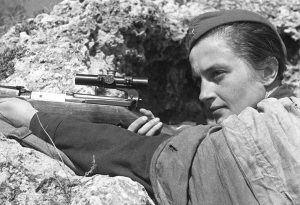 On Friday, November 12, 1942, Pavlichenko visited Coventry, accepting donations of £4,516 from local workers to pay for three X-ray units for the Red Army. She also visited Coventry Cathedral ruins, then the Alfred Herbert works and Standard Motor Factory, from where most funds had been raised. She had inspected a factory in Birmingham earlier in the day. Having attained the rank of major, Pavlichenko never returned to combat, but became an instructor and trained Soviet snipers until the war’s end. In 1943, she was awarded the Gold Star of the Hero of the Soviet Union, as well as the Order of Lenin twice. Lyudmilla Pavlichenko died on October 10, 1974, at the age of 58 years in Moscow, Soviet Union due to a stroke. She was a beloved hero of the Soviet Union.
On Friday, November 12, 1942, Pavlichenko visited Coventry, accepting donations of £4,516 from local workers to pay for three X-ray units for the Red Army. She also visited Coventry Cathedral ruins, then the Alfred Herbert works and Standard Motor Factory, from where most funds had been raised. She had inspected a factory in Birmingham earlier in the day. Having attained the rank of major, Pavlichenko never returned to combat, but became an instructor and trained Soviet snipers until the war’s end. In 1943, she was awarded the Gold Star of the Hero of the Soviet Union, as well as the Order of Lenin twice. Lyudmilla Pavlichenko died on October 10, 1974, at the age of 58 years in Moscow, Soviet Union due to a stroke. She was a beloved hero of the Soviet Union.

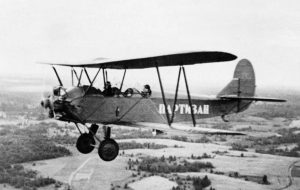 During and before World War II, and even after to a large degree, women were not allowed to hold combat positions, but the Soviets found that the enemy was fast encroaching on them, and there was no other choice. Using female bombardiers was even more undesirable, but Adolf Hitler had launched Operation Barbarossa, which was his massive invasion of the Soviet Union, in June 1941. By that autumn, the Germans were pressing on Moscow, Leningrad was under siege and the Red Army was struggling. The Soviets were desperate.
During and before World War II, and even after to a large degree, women were not allowed to hold combat positions, but the Soviets found that the enemy was fast encroaching on them, and there was no other choice. Using female bombardiers was even more undesirable, but Adolf Hitler had launched Operation Barbarossa, which was his massive invasion of the Soviet Union, in June 1941. By that autumn, the Germans were pressing on Moscow, Leningrad was under siege and the Red Army was struggling. The Soviets were desperate.
Marina Raskova, who was also known as the “Soviet Amelia Earhart,” had brainstormed the idea of a female squadron. She was famous not only as the first female navigator in the Soviet Air Force but also for her many long-distance flight records. Marina had been receiving letters from women all across the Soviet Union wanting to join the World War II war effort. Oh sure, they could go in as nurses, secretaries, or in some other support roles, but these women already knew how to fly. They had been training in air clubs all over the Soviet Union. They wanted to be gunners and pilots, flying on their own. Many of these women had lost brothers or boyfriends, and many had seen their homes and villages destroyed. Raskova petitioned Soviet dictator Joseph Stalin to let her form an all-female fighting squadron. Stalin wasn’t too keen on the idea, but it soon became apparent that they had no other choice.
On October 8, 1941, Stalin agreed to the plan and gave orders to deploy three all-female air force units. These women were going to be full-combat soldiers. They would not only fly missions and drop bombs, they would return fire too. With this action, the Soviet Union became the first nation to officially allow women to engage in combat. Previously, even women pilots could only help transfer planes and ammunition. Then, the men took over. Raskova quickly started to fill out her teams. She had more than 2,000 applications to choose from. She selected about 400 women for each of the three units. These were not long time pilots, but rather, most were students, ranging in age from 17 to 26. Those selected moved to Engels, a small town north of Stalingrad, to begin training at the Engels School of Aviation. The women underwent a highly compressed education, and were expected to learn in a few months what it took most soldiers several years to grasp. The only thing in their favor was that they already knew how to fly, just not in combat. Each recruit had to train and perform as pilots, navigators, maintenance and ground crew. Then the positions were assigned. The women faced skepticism from most of the male military personnel who believed they added no value to the combat effort, and called them “princesses.” Raskova did her best to prepare her women for these attitudes, but they still faced sexual harassment, long nights, and grueling conditions. “The men didn’t like the ‘little girls’ going to the front line. It was a man’s thing.” Assigned Polikarpov Po-2 biplanes, which was a bare-bones plywood biplane, the women flew under the cover of night. These light two-seater, open-cockpit planes were never meant for combat, and were often referred to as “a coffin with wings.” Made out of plywood with canvas pulled over, the aircraft offered virtually no protection from the elements. Flying at night, pilots endured freezing temperatures, wind, and frostbite. In the harsh Soviet winters, the planes became so cold, touching them caused skin to stick and rip off. They were given uniforms handed down from the men, and boots that were too big, and had to have the toes stuffed, so they would not slip.
In the air, they braved bullets and frostbite, while on the ground, they battled skepticism and sexual harassment. Nevertheless, in the air, they were so feared and hated by the Nazis that any German airman who downed one of these planes was automatically awarded the prestigious Iron Cross medal. All told, the unique all-female 588th Night Bomber Regiment dropped more than 23,000 tons of bombs on Nazi targets. And in doing so, they became a crucial Soviet asset in winning World War II. The Germans nicknamed them the Nachthexen, or “night witches,” because the whooshing noise their wooden planes made resembled that of a sweeping broom. “This sound was the only warning the Germans had. The planes were too small to show up on radar, or on infrared locators,” said Steve Prowse, author of the screenplay The Night Witches, a nonfiction account of the little-known female squadron. “They never used radios, so radio locators couldn’t pick them up either. They were basically ghosts.”
Due to both the planes’ limited weight capacity and the military’s limited funds, the female pilots didn’t have some of the basic necessities. Parachutes were deemed a “luxury” item. The added weight was just too much. They also didn’t have radar, guns, and radios. They were forced to use more rudimentary tools such as rulers, stopwatches, flashlights, pencils, maps, and compasses. Because these planes flew slower than the stall speed of the Nazi planes, they were very good at maneuvering out of the way of the German planes, making them hard to target. They also could easily take off and land from most locations. Still, there was a downside too. Whenever they did come under enemy fire, the pilots had to duck by sending their planes into dives, because most of them carried no defense ammunition. If they were hit by tracer bullets, which carry a pyrotechnic charge, the wooden planes would burst into flames, killing the crew.
One of the biggest drawbacks was that the Polikarpovs could only carry two bombs at a time…one under each wing. Two bombs per plane was not going to make much of a dent in the German targets, so the regiment sent out up to 40 two-person crews a night. Each would fly between 8 and 18 missions a night, returning to base to re-arm between runs. The weight of the bombs forced them to fly at lower altitudes, making them a much easier target, which is why they only flew missions at night. Each mission found the planes traveling in packs. The first planes were used as bait. Their job was to attract German spotlights, which provided the pack with much needed illumination. These bait-planes, rarely had ammunition to defend themselves. They would release a flare to light up the intended target. The last plane would idle its engines and glide in darkness to the bombing area. It was this “stealth mode” that created their signature witch’s broom sound. While these women were a formidable foe, they were also women. The Night Witches followed 12 commandments, the first of which was “be proud you are a woman.” They might be fierce killers of the Germans, but in their downtime they were still women. They did needlework, patchwork, decorated their planes and danced. They even put the pencils they used for navigation into double duty as eyeliner.
The last flight of the Night Witches took place on May 4, 1945…when they flew within 37 miles of Berlin. Three days later, Germany officially surrendered. According to Prowse, “the Germans had two theories about why these women were so successful: They were all criminals who were masters at stealing and had been sent to the front line as punishment, or they had been given special injections that allowed them to see in the night,” both of these “theories” make me laugh, like the female pilots couldn’t be just that…excellent fighter pilots in their own right. Altogether these capable, albeit “crazy” heroines flew more than 30,000 missions, or about 800 per pilot and navigator. They lost a total of 30 pilots, and 24 of the flyers were awarded the title Hero of the Soviet Union. Marina Raskova, who had spearheaded the movement, died on January 4, 1943, when her plane was shot down on a mission very near the front line. Hers was the very first state funeral of World War II and 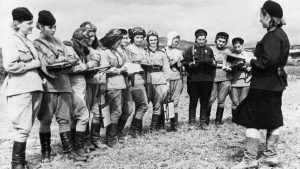
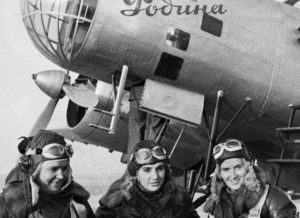 her ashes were buried in the Kremlin. The all-female 588th Night Bomber Regiment, despite being the most highly decorated unit in the Soviet Air Force during the World War II, was disbanded six months after the end of the war. When the big victory-day parade in Moscow was held, they weren’t included, because it was decided that their planes were too slow. Amazing!!!
her ashes were buried in the Kremlin. The all-female 588th Night Bomber Regiment, despite being the most highly decorated unit in the Soviet Air Force during the World War II, was disbanded six months after the end of the war. When the big victory-day parade in Moscow was held, they weren’t included, because it was decided that their planes were too slow. Amazing!!!
 It was a big move for a Milwaukee, Wisconsin girl, but in the end, it would be her undoing. Mildred Fish was born in Milwaukee in 1902, and upon her high school graduation, she studied and then taught English at UW-Madison. It was there that she met Arvid Harnack, a Rockefeller Fellow from Germany. They soon fell in love, and were married in 1926. Because she was a progressive woman and proud of her name, Mildred chose to hyphenate her name, and became known as Mildred Fish-Harnack.
It was a big move for a Milwaukee, Wisconsin girl, but in the end, it would be her undoing. Mildred Fish was born in Milwaukee in 1902, and upon her high school graduation, she studied and then taught English at UW-Madison. It was there that she met Arvid Harnack, a Rockefeller Fellow from Germany. They soon fell in love, and were married in 1926. Because she was a progressive woman and proud of her name, Mildred chose to hyphenate her name, and became known as Mildred Fish-Harnack.
A few years later, she and Arvid both moved to Germany, where she taught and also worked on her doctorate while he worked for the German government. It was during those years that Fish-Harnack became interested in the Soviet Union, where women could choose where to work and also had other rights that women in the United States did not have…a situation which would very soon sound absurd. Nevertheless, at that time, it was so. Throughout the 1930s, Mildred and Arvid, who became increasingly 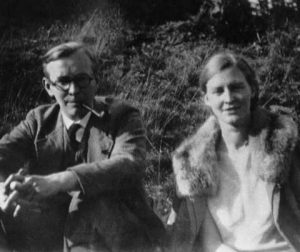 alarmed by Hitler’s rise to power, began to communicate with a close circle of associates who believed communism and the Soviet Union might be the only possible stumbling block to complete Nazi tyranny in Europe. As the Hitler and the Nazi regime began to come into power, Fish-Harnack and her husband joined a small resistance group, which the Nazi secret police…the Gestapo…would later call the Red Orchestra. This resistance group smuggled important secrets about the Nazis to the United States and Soviet governments and helped Jews escape from Germany. When war was declared in 1941, she did not leave with other American expatriates.
alarmed by Hitler’s rise to power, began to communicate with a close circle of associates who believed communism and the Soviet Union might be the only possible stumbling block to complete Nazi tyranny in Europe. As the Hitler and the Nazi regime began to come into power, Fish-Harnack and her husband joined a small resistance group, which the Nazi secret police…the Gestapo…would later call the Red Orchestra. This resistance group smuggled important secrets about the Nazis to the United States and Soviet governments and helped Jews escape from Germany. When war was declared in 1941, she did not leave with other American expatriates.
Of course, their activities were espionage and would eventually cost them their lives. For his part, her husband, 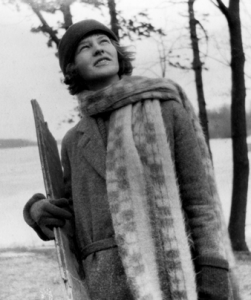 Arvid was hanged in December 1942. Mildred was given a six year sentence, but Hitler refused to endorse her punishment and she was retried and condemned on February 16, 1943. She was beheaded by guillotine. Because of her connection to possible communist sympathies and post-war McCarthyism, her story is virtually unknown in the United States. She was the only American woman who was ever put to death on the direct order of Adolf Hitler for her involvement in the resistance movement. Her last words were, “And I have loved Germany so much.” In the Cold War years after World War II, Fish-Harnack’s name and legacy were not honored in the United States, because she and her husband were believed to have been connected with Communism. For a time they were hated by both of their home countries. Once the truth came out in 1986, that changed and Mildred Fish-Harnack Day was established in Wisconsin. It takes place every year on her birthday, September 16th.
Arvid was hanged in December 1942. Mildred was given a six year sentence, but Hitler refused to endorse her punishment and she was retried and condemned on February 16, 1943. She was beheaded by guillotine. Because of her connection to possible communist sympathies and post-war McCarthyism, her story is virtually unknown in the United States. She was the only American woman who was ever put to death on the direct order of Adolf Hitler for her involvement in the resistance movement. Her last words were, “And I have loved Germany so much.” In the Cold War years after World War II, Fish-Harnack’s name and legacy were not honored in the United States, because she and her husband were believed to have been connected with Communism. For a time they were hated by both of their home countries. Once the truth came out in 1986, that changed and Mildred Fish-Harnack Day was established in Wisconsin. It takes place every year on her birthday, September 16th.
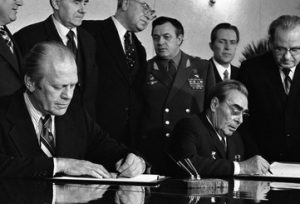 During the Cold War, the threat of a nuclear attack was the biggest concern in world relationships. During the late 1960s, the United States learned that the Soviet Union had embarked upon a massive Intercontinental Ballistic Missile (ICBM) buildup designed to catch up with the United States. The situation seemed to be heating up, because the Soviet Union seemed far more likely to use such weapons, so it looked like it was time to take action. In January 1967, President Lyndon Johnson announced that the Soviet Union had begun to construct a limited Anti-Ballistic Missile (ABM) defense system around Moscow. The development of an ABM system could allow one side to launch a first strike and then prevent the other from retaliating by shooting down incoming missiles. That was completely unacceptable.
During the Cold War, the threat of a nuclear attack was the biggest concern in world relationships. During the late 1960s, the United States learned that the Soviet Union had embarked upon a massive Intercontinental Ballistic Missile (ICBM) buildup designed to catch up with the United States. The situation seemed to be heating up, because the Soviet Union seemed far more likely to use such weapons, so it looked like it was time to take action. In January 1967, President Lyndon Johnson announced that the Soviet Union had begun to construct a limited Anti-Ballistic Missile (ABM) defense system around Moscow. The development of an ABM system could allow one side to launch a first strike and then prevent the other from retaliating by shooting down incoming missiles. That was completely unacceptable.
President Johnson decided to call for strategic arms limitations talks…nicknamed SALT, and in 1967, he and Soviet Premier Alexei Kosygin met at Glassboro State College in New Jersey. Johnson said they must gain “control of the ABM race,” and Secretary of Defense Robert McNamara argued that the more each reacted to the other’s escalation, the more they had chosen “an insane road to follow.” Completely abolishing nuclear weapons would be impossible, but limiting the development of both offensive and defensive strategic systems could be done, and it might help stabilize relations between the 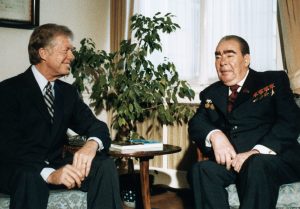 United States and the Soviet Union. The resulting SALT-I treaty was signed in 1972. The 1972 treaty limited a wide variety of nuclear weapons, but it did not address many of the other issues, so shortly after the SALT-I treaty was ratified, talks between the United States and the Soviet Union began anew. Those talks failed to achieve any new breakthroughs. By 1979, both the United States and the Soviet Union were eager to try again. For the United States, the thought that the Soviets were leaping ahead in the arms race was the primary motivator. For the Soviet Union, the increasingly close relationship between America and communist China was a cause for growing concern.
United States and the Soviet Union. The resulting SALT-I treaty was signed in 1972. The 1972 treaty limited a wide variety of nuclear weapons, but it did not address many of the other issues, so shortly after the SALT-I treaty was ratified, talks between the United States and the Soviet Union began anew. Those talks failed to achieve any new breakthroughs. By 1979, both the United States and the Soviet Union were eager to try again. For the United States, the thought that the Soviets were leaping ahead in the arms race was the primary motivator. For the Soviet Union, the increasingly close relationship between America and communist China was a cause for growing concern.
The SALT-II agreement was the result of those many nagging issues that were left over from the successful SALT-I treaty of 1972, but it had problems of its own. The treaty basically established numerical equality between the two nations in terms of nuclear weapons delivery systems. It also limited the number of MIRV missiles (missiles with multiple, independent nuclear warheads). In truth, the treaty did little or nothing to stop, or even substantially slow down, the arms race, and it met with unrelenting criticism in the United States. The treaty was thought to be a “sellout” to the Soviets. People believed that it would leave America virtually defenseless against a whole range of new weapons not mentioned in the agreement. Even supporters of arms control were less than enthusiastic about the treaty, since it did little to actually control arms. Nevertheless, during a summit meeting in Vienna, President Jimmy Carter and Soviet leader Leonid Brezhnev signed the 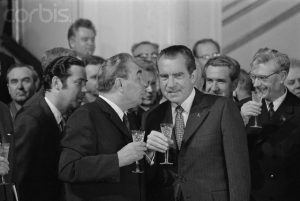 SALT-II agreement dealing with limitations and guidelines for nuclear weapons, on June 18, 1979. The treaty, would never formally go into effect, and it proved to be one of the most controversial agreements between the United States and the Soviet Union of the entire Cold War. Debate over SALT-II in the U.S. Congress continued for months. Then in December 1979, the Soviets invaded Afghanistan. The Soviet attack effectively killed any chance of SALT-II being passed, and Carter ensured this by withdrawing the treaty from the Senate in January 1980. SALT-II thus remained signed, but was never ratified. During the 1980s, both nations agreed to respect the agreement until such time as new arms negotiations could take place.
SALT-II agreement dealing with limitations and guidelines for nuclear weapons, on June 18, 1979. The treaty, would never formally go into effect, and it proved to be one of the most controversial agreements between the United States and the Soviet Union of the entire Cold War. Debate over SALT-II in the U.S. Congress continued for months. Then in December 1979, the Soviets invaded Afghanistan. The Soviet attack effectively killed any chance of SALT-II being passed, and Carter ensured this by withdrawing the treaty from the Senate in January 1980. SALT-II thus remained signed, but was never ratified. During the 1980s, both nations agreed to respect the agreement until such time as new arms negotiations could take place.

